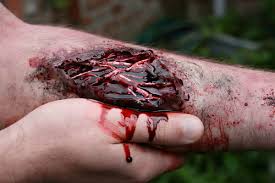Nurse Rudolf documents the presence of a scab on a client’s deep wound.
The nurse identifies this as which phase of wound healing?
- A- Inflammatory
- B- Migratory
- C- Proliferative
- D- Maturation
Answer B.
- The scab formation is found in the migratory phase.
- It is accompanied by migration of epithelial cells, synthesis of scar tissue by fibroblasts, and development of new cells that grow across the wound.
- In the inflammatory phase, a blood clot forms, epidermis thickens, and an inflammatory reaction occurs in the subcutaneous tissue.
- During the proliferative phase, the actions of the migratory phase continue and intensify, and granulation tissue fills the wound.
- In the maturation phase, cells and vessels return to normal and the scab sloughs off.
Here's a deeper dive into the fascinating world of wound healing, focusing on the migratory phase and scab formation:
The Migratory Phase: A Cellular Orchestra
Imagine a complex dance where different cell types work together to heal a wound. The migratory phase is exactly that. Here's what happens:
- Epithelial Cells on the Move: These are the building blocks of your skin. When a wound occurs, nearby healthy epithelial cells get activated and start migrating inwards, like a living bridge, to cover the exposed area.
- Fibroblasts Get Busy: Underneath the migrating epithelial cells, fibroblasts become the workhorses. They churn out collagen, a protein that forms the foundation of scar tissue, providing strength and structure to the healing wound.
- Scab Formation: A Protective Shell: As the epithelial cells migrate and the underlying area fills with collagen, a scab starts to form. This scab is essentially dried blood plasma, fibrin (a clotting protein), and dead cells. It acts as a protective cover, shielding the delicate new tissue beneath from infection, dehydration, and external damage.
Beyond the Basics: Factors Affecting Scab Formation
Several factors influence scab formation and the overall healing process:
- Wound Depth and Size: Deeper wounds take longer to heal and may form thicker scabs. Larger wounds also require more extensive cellular migration and collagen production.
- Blood Supply: Good blood flow delivers vital oxygen and nutrients to the wound bed, facilitating cell migration and tissue growth. Poor circulation can delay healing and scab formation.
- Infection: If bacteria invade the wound, the body's immune response goes into overdrive, potentially delaying scab formation and prolonging healing.
- Moisture Balance: Keeping the wound moist promotes cell migration and tissue growth. Conversely, a dry wound creates a barrier to migration and can lead to a harder, less flexible scab.
Remember:
Scab formation is a natural part of healing, but it's important not to pick at it. Picking can disrupt the delicate new tissue underneath and increase the risk of scarring or infection. Let the scab fall off naturally as the healing progresses.
